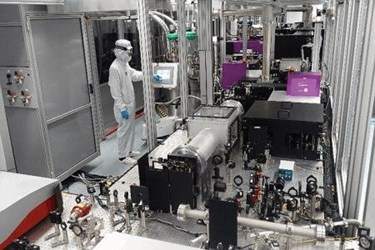British, Czech Scientists Fire World's Most Powerful Superlaser
By Jof Enriquez,
Follow me on Twitter @jofenriq

Scientists at Britain's Central Laser Facility (CLF) and HiLASE (High average power pulsed laser), a Czech state research and development center, claim to have built and tested the world's highest powered "super laser," more than ten times as powerful as similar lasers. The world record was set Dec. 16, 2016, when the super laser broke the "magical barrier" of 1,000 watts.
Nicknamed "Bijov" after a mythical Czech strongman, the super laser weighs in at 20 tons and cost 44 million euros ($48 million) to build at the testing facility in Dolni Brezany, near Prague. This "high peak power laser" can pump out sustained, high-energy pulses of 1,000-watts of average power — much more potent than the other two existing peak power lasers, which can achieve maximum output just several times a day.
"[Those lasers] do not have so-called 'average power.' This is a combination of the repetition rate and the energy. Our laser has the highest average power, which is important. The repetition rate in Osaka and Austin is significantly lower," HiLASE director Tomas Mocek told AFP, referring to the two other petawatt lasers’ locations.
A petawatt is equivalent to one quadrillion watts, and petawatt lasers are the most powerful light sources ever created on earth.
The one-petawatt Texas Petawatt Laser at the University Of Texas At Austin, Texas, previously held the title of most powerful laser in the world, when it exceeded one petawatt of laser power on March 31, 2008.
Scientists working at the two-petawatt Laser for Fast Ignition Experiments (LFEX) in Osaka, Japan, in July 2015 claimed that the pulse from their super laser reached 2 petawatts at 1 picosecond, or about 100 times the energy of UT Austin’s laser, and twice its peak power, according to Popular Science.
For comparison's sake, the fictitious first Death Star's planet-destroying super laser was capable of discharging 2.4×1032 watts, or one hundred nonillion watts of power.
The team of British and Czech scientists have more benevolent aspirations for their super laser, which is tipped to possess "revolutionary potential in engineering, for hardening metal surfaces, processing semiconductors and micro-machining material," according to AFP.
They plan to conduct more testing at the Dolni Brezany facility later this month, with plans to commercialize the super laser in the second half of the year.
"It is a world record which is important," CLF director John Collier told AFP. "It is good for putting things on the map, but the more important point is that the underlying technology that has been developed here is going to transform the application of these high power, high energy lasers."
Yet another, more powerful petawatt laser – the High-Repetition-Rate Advanced Petawatt Laser System (HAPLS) – could claim the title of world's most powerful super laser soon. It will be installed in the European Union’s Extreme Light Infrastructure (ELI) Beamlines facility in the Czech Republic. HAPLS will feature the highest peak power laser diode arrays in the world, capable of generating peak powers greater than one petawatt (1 quadrillion watts, or 1015) at a repetition rate of 10 Hertz, with each pulse lasting 30 femtoseconds (30 quadrillionths of a second).
